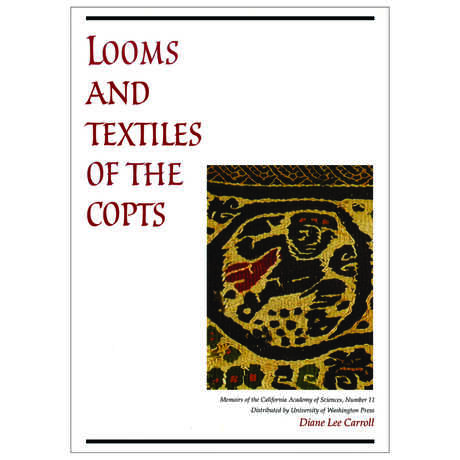First Millennium Egyptian Textiles in the Carl Austin Rietz Collection
of the California Academy of Sciences
Diane Lee Carroll

While textiles rarely survive in the archaeological record, the dry desert tombs of Egypt have preserved large numbers from multiple eras. Yet despite a plethora of samples, the Coptic period of Egypt (the first millennium of the Christian era) is often overlooked in favor of the more studied periods of the ancient pharaohs and the Arab conquest.
In the mid-1900s, San Francisco Bay Area industrialist Carl Austin Rietz collected over 75 Coptic textile fragments, a collection which now resides at the California Academy of Sciences. In Looms and Textiles of the Copts, Diane Lee Carroll discusses the history, manufacturing techniques and motifs of Coptic-era textiles, using the Rietz collection as her study group.
Looms and Textiles of the Copts: First Millennium Egyptian Textiles in the Carl Austin Rietz Collection of the California Academy of Sciences was published as Memoirs of the California Academy of Sciences, No. 11, San Francisco, California, 1988. 201 pages, 16 color plates, 98 black & white photographs. Soft cover. ISBN 0-295-96672-6.
The entire collection of Coptic textiles at the California Academy of Sciences is available to view online.
CONTENTS
Introduction
I. The Coptic Weaver's Inheritance: Ancient Textile Technology
II. Coptic Textile Technology: The Literary and Archaeological Evidence
III. Coptic Textile Design: The Greek and Roman Sources
IV. Coptic Motifs: Some Philosophical Concepts
V. Significant Dates: The Historical Background
VI. The Rietz Coptic Textiles: An Illustrated Catalog
VII. Glossary
Bibliography
Acknowledgments
Index
ORDERING INFORMATION:
Looms and Textiles of the Copts: First Millennium Egyptian Textiles in
the Carl Austin Rietz Collection of the California Academy of Sciences
$ 16.29 California (with 8.625% California sales tax)
$ 15.00 Domestic (non-California U.S. shipping addresses)
$ 20.00 International (non-U.S. shipping addresses)
All prices include shipping & handling. Shipping will be by the most economical means. Air or express shipping is available at additional cost. For further information, contact the Department at the address below.
Payment must be received before your order can be processed. Only checks, money orders, and credit cards (Visa, MasterCard, American Express) can be accepted. Payment must be made in U.S. dollars. Make check or money order payable to California Academy of Sciences: Anthropology.
Please allow 2-3 weeks for processing and shipping.
TO ORDER: Click here to download a printable PDF mail order form. Or have the following information ready, then call 415-379-5383:
Shipping information
* Contact name
* Name of organization, if applicable
* Shipping address
* Telephone number
Order information
* Publication title
* Quantity of each title/type
Payment information
* Type of card (Visa, MasterCard or American Express)
* Name as it appears on the card
* Credit card number
* 3- or 4-digit security code
* Expiration date
* Billing address (if different from shipping address)
Privacy policy: all information received will be used exclusively for the purpose of completing the order and will not be shared with any other individual or organization.
Questions? Contact the Department:
Anthropology Publications
California Academy of Sciences
55 Music Concourse Drive
San Francisco, CA 94118
Phone: 415-379-5383
Email: anthropology at calacademy dot org
Last updated 07 January 2025
Share This
Catalogs of the Academy's Anthropology collection are available to purchase from the Department.
Our permanent research collection consists of more than 16,000 objects, most of which are ethnographic. Current strengths include holdings from the U.S. Southwest and the Pacific Islands, and basketry from California. Our searchable online database features the entire Anthropology collection, including digital images for every piece.
The Department of Anthropology houses a collection of hominin fossil and comparative casts that are available for reference by visiting researchers and students.